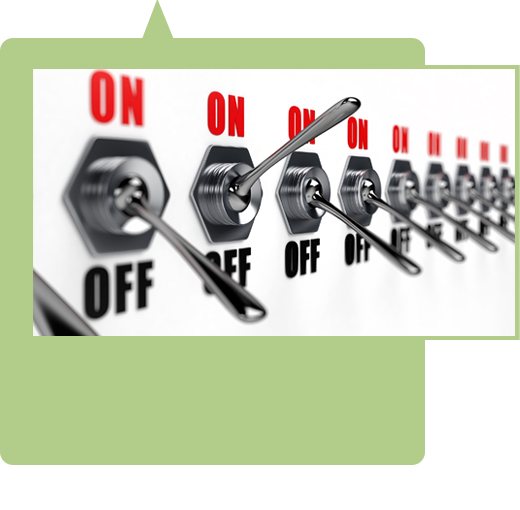Efficient use of resources is an essential part of business sustainability. Reducing your energy and fuel consumption will reduce costs as well as improving your environmental sustainability performance. For many businesses energy and fuel savings can be made throughout its operations. Water is a significant factor for some businesses; inefficient use of raw materials might be the biggest issue for others.
All your employees can affect the efficient use of resources in day to day operations. Employees ‘at the coal face’ often have good ideas about how to reduce energy, fuel and water use, minimise reject products and wastage and what to recycle or reuse.
Operational resource efficiency focuses on what can be achieved at the operational, shop floor or team level. However any efficiency improvements will be temporary if the new practices are not supported by management and not embedded into daily procedures and workplace culture – “how we do business”. Encouraging employees to take a personal interest in sustainability will help to embed new practices and procedures that might otherwise fall by the wayside. However, a targeted change management approach might be needed to help you address any pockets of resistance.

Sustainable practice in resource efficiency
Systematic approach
A systematic approach to resource efficiency can help you achieve big savings in areas they are needed. Applied in this context Lean, Competitive Systems and Practices and Sustainable Operations offer tools and techniques to help you:
- Measure and analyse your resource usage
- Decide where to target improvements
- Plan, implement and evaluate improvements
- Sustain and build on them.
Fuel consumption
Many businesses have reduced fuel consumption by educating their drivers in ‘eco’ driving methods. These driving techniques are estimated to improve fuel efficiency by up to 25%.
If this is an area you want to target your guidelines and training for drivers might cover:
- Smooth driving techniques – avoiding unnecessary braking and fast acceleration
- Using the optimum gear to balance power and fuel economy
- How to manage loads to reduce drag
- Choosing a cruising speed that balances schedule requirements and fuel consumption
- Correct tyre pressure and how often they should be checked (acknowledged to deliver up to 5% improvement)
- When to turn off engine rather than leave it idling
- When to use air conditioning vs open windows.
Regular maintenance and servicing can also help to maintain good fuel performance as well as reduce costly avoidable repairs.
Coordinating deliveries can help to minimise the number of trips needed. You can plan routes to miminise the distance, but may need to balance this against the likely road and traffic conditions. Reviewing your packaging, palleting and stacking techniques and analysing the shape and size of your vehicles can help to maximise the amount that can be transported in one load.

Energy efficiency
There are many ways to improve your energy efficiency. You may find that you can make significant savings by focusing on equipment, lighting and heating that can be switched off at certain times. You can decide whether to manage this through procedures and behaviour change or whether to install automated systems such as movement triggered light switches. You could focus on bathroom lights that do not need to be on until people need them or you might tackle power consumption during shut down periods.
You could focus on a section, team or piece of equipment and work to optimise its energy consumption while maintaining (or improving) productivity rates. In addition to direct savings this could provide a blueprint for other optimisation projects.
You may also find that waste heat (or cooling) from one process can be used by another. While this will usually require some expenditure, the savings may pay for it.
You might find that heat/cooling is contributing to inefficiency. Lagging (insulation) may have fallen off, become damaged or is not effective for some other reason. Steam traps might be passing or leaking. These things are often easy to check regularly and any expense to fix them is usually recovered quickly from the savings.
Water
Your production processes may not require high volumes of water and it may seem that you can’t reduce your water usage. However a significant amount of water can be saved with simple measures that don’t require a huge budget. These might be things that your staff already do at home; and they may have great ideas to bring to the workplace.
Installing water saving devices such as high velocity/low volume hose nozzles, aerators on taps and low flush toilets can save noticeable amounts of water at fairly low cost. Planting drought resistant plants, investing in a water saving dishwasher for the lunch room and fixing leaking taps and toilet cisterns can also achieve significant water savings. You can encourage staff to report any leaks and make water saving suggestions and back it up with a simple reporting system and prompt action.
Your operations might rely on high water consumption. This might make it cost effective to install water tanks or to investigate systems that enable you to treat and reuse water. These are likely to require capital expenditure and senior management approvals and may not be achievable within day to day efficiency activities.
Managing your performance
There are many areas you could focus your efforts to increase operational resource efficiency. Things to think about include:
- Commitment to a systematic approach such as Lean and the Sustainable Operations qualifications
- Setting targets and evaluating what improvements are achieved
- Providing opportunities for employees to contribute their skills and knowledge
- Training, pilot programs, champions and other ways to promote change and commitment
- Applying improvements your employees would use at home as well as big picture industrial ones.
See More information.

